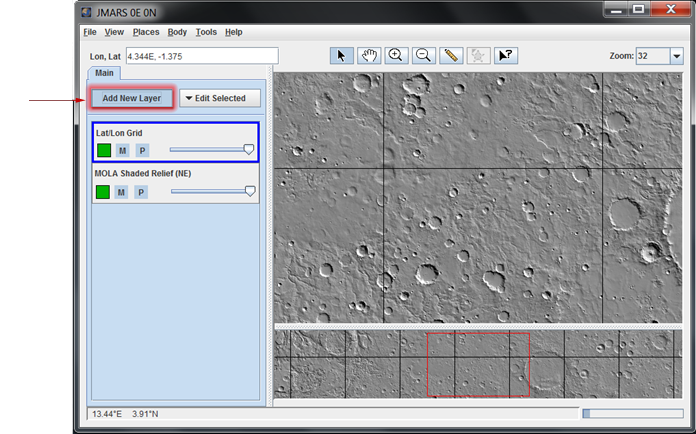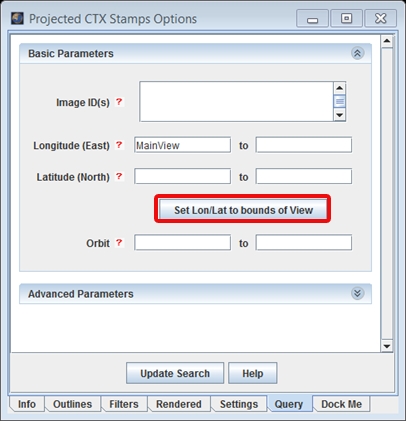- Home
- Getting Started
- Documentation
- Release Notes
- Tour the Interface
- Tour the Layers
- JMARS Video Tutorials
- Lat/Lon Grid Layer
- Map Scalebar
- Nomenclature
- Crater Counting
- 3D
- Shape Layer
- Mosaics
- Map
- Advanced/Custom Maps
- Graphic/Numeric Maps
- Custom Map Sharing
- Stamp
- THEMIS
- MOC
- Viking
- CRISM Stamp Layer
- CTX
- HiRise
- HiRISE Anaglyph
- HiRISE DTM
- HRSC
- OMEGA
- Region of Interest
- TES
- THEMIS Planning
- Investigate Layer
- Landing Site Layer
- Tutorials
- Video Tutorials
- Displaying the Main View in 3D
- Finding THEMIS Observation Opportunities
- Submitting a THEMIS Region of Interest
- Loading a Custom Map
- Viewing TES Data in JMARS
- Using the Shape Layer
- Shape Layer: Intersect, Merge, and Subtract polygons from each other
- Shape Layer: Ellipse Drawing
- Shape Layer: Selecting a non-default column for circle-radius
- Shape Layer: Selecting a non-default column for fill-color
- Shape Layer: Add a Map Sampling Column
- Shape Layer: Adding a new color column based on the values of a radius column
- Shape Layer: Using Expressions
- Using JMARS for MSIP
- Introduction to SHARAD Radargrams
- Creating Numeric Maps
- Proxy/Firewall
- JMARS Shortcut Keys
- JMARS Data Submission
- FAQ
- Open Source
- References
- Social Media
- Podcasts/Demos
- Download JMARS
JMARS ›
Context Camera (CTX) Stamp Layer
The CTX Stamp Layer will display stamps for all images acquired by the Context Camera (CTX) aboard the Mars Reconnaissance Orbiter. While the search interface is similar to the THEMIS Stamp Layer, there are some differences that allow users to search for images based on the unique parameters associated with CTX images.

Open the CTX Stamp Layer
- Open the Stamp Layer: Chose "Add New Layer" -> Click the drop-down menu and select "Imagery" -> Make sure "Image sets" is selected and click "CTX".




- Search Parameter Categories: The search parameters are divided into categories since there are so many of them. Clicking on the down arrow on the right side of the category name will reveal all the search parameters in that category. The categories are:
- Basic Parameters
- Advanced Parameters
- Enter Search Parameters: It is not necessary to enter values for each parameter, but the more specific your search the faster it will be. The allowable values for each field are given in the quick reference table below.
- You can also query the stamps for the Mainview only by clicking "Set Lon/Lat to bounds of View".
- Perform Image Search: Clicking OK will make the Stamp Layer perform the search and display the results. Depending on how specific the search parameters are, it may take the Stamp Layer a few minutes to find and create stamps for all of the images. Once the stamps are displayed in the Viewing Window, users can right-click on an outline to either render the image (display the image data in JMARS) or view the image in a web browser.

CTX Search Parameter Glossary
|
Filter Type |
Acceptable Values |
Description |
|
Image ID(s) |
Any Specific Image ID Number(s) |
A unique identifier for each image commanded; follow the pattern PPP_NNNNNN_TTTT_"X"X_AAHBBB"W", where
|
|
Min/Max Longitude |
0 to 360(East Longitude = Positive) |
This is the approximate longitude on the planet Mars of the image center. All values are based on the IAU 2000 aerocentric model of Mars with east positive longitude. (gives in degrees of East Longitude) |
|
Min/Max Latitude |
90 to -90(North Latitude = Positive) |
This is the approximate latitude on the planet Mars of the image center. All values are based on the IAU 2000 aerocentric model of Mars with north positive latitude. |
|
Min/Max Orbit |
Any Orbit Range |
MRO orvit during which the image was acquired. |
|
Mission Phase |
POST-MOI - Post Mars Orbit Insertion |
The MRO/CTX mission has been divided into the following phases. |
|
Spatial Summing |
1 - 2(1=Full Resolution, 2=Half Resolution) Blank(Any Spatial Summing) |
Spatial average of NxN pixels of data before downlink; summing=1 implies that no spatial averaging has been applied. |
|
Scaled Pixel Width |
1.0 - 77.00 (inmeters/pixel) |
This is the image resolution in meters per pixel at the center of the image. |
|
Lines |
0 - 105,000 |
The number of horizontal lines of pixels contained in the image. |
|
Line Samples |
0 - 5056 |
The number of pixels in each line of the image. |
|
Min/Max Solar Longitude |
0 - 360(0=Northern Vernal Equinox ) |
This is the position of Mars relative to the Sun measured in degrees from the vernal equinox (start of northern Spring). This number is used as a measure of Martian seasons. (Also known as heliocentric longitude and abbreviated Ls.) a) Northern Spring/Southern Autumn start at 0° b) Northern Summer/Southern Winter start at 90° c) Northern Autumn/Southern Spring start at 180° d) Northern Winter/Southern Summer begin at 270° |
|
Local Time (24hr) |
00:00-24:00(Given as HH:MM in Mars time) |
This is the local time on Mars at the center of the image relative to a division of the martian day into 24 equal parts. A martian day is slightly longer than 24 hours and 37 minutes long. |
|
Min/Max Solar Incidence Angle |
0 - 180(0=Sun Directly Overhead) |
Derived for the center of the image, this is the angle between the Sun and a "normal" drawn perpendicular to the planet's surface at the time the image was acquired. A higher incidence angle means that a person standing on the ground would see the sun lower toward the horizon. |
|
Min/Max Emission Angle |
0 - 180(0=CTX Directly Overhead) |
Measured from the center of the image, this is the angle between the CTX and a "normal" drawn perpendicular to the planet's surface. |
|
Phase Angle |
0 - 180(0=CTX and Sun In-Line) |
This is the angle between the sun, the surface, and the CTX at the time the picture was obtained. |
|
Slant Distance |
0 - 5000(Distance from sub-MRO point to image center, in meters) |
This number is similar to the spacecraft altitude, but also takes into account the emission angle. If the emission angle is 0 then this number is the same as the spacecraft altitude. If the emission angle is much greater than 0, then the "slant distance" to the surface at the center of the image is also greater than the spacecraft altitude. |
|
Rationale Description |
Any Text |
A short description of why the image was targeted. |


Stamp Layer Functions
The CTX Camera Stamp Layer's functions are identical to the functions of the Stamp Layer and are explained in detail on the Stamp Layer page.



